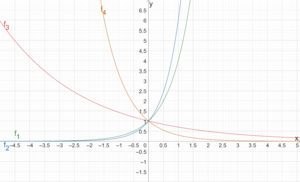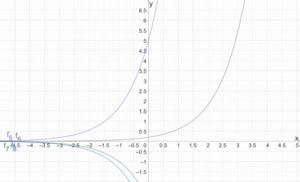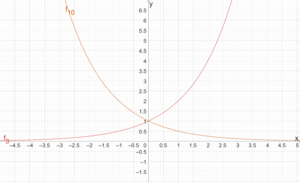Exponentialfunktion: Unterschied zwischen den Versionen
Keine Bearbeitungszusammenfassung |
|||
| Zeile 2: | Zeile 2: | ||
==Definition== | ==Definition== | ||
Eine [[Funktion]] der Form <math>f(x)=c \cdot a^x</math> mit <math>c \in \mathbb{R},~a \geq 0,~a \neq 1</math> heißt '''allgemeine Exponentialfunktion zur Basis a'''. | Eine [[Funktion]] der Form <math>f(x)=c \cdot a^x</math> mit <math>a,~c \in \mathbb{R},~a,~c \geq 0,~a \neq 1</math> heißt '''allgemeine Exponentialfunktion zur Basis a'''. | ||
<math>c</math> ist der '''y-Achsenabschnitt'''. Der '''Schnittpunkt mit der y-Achse''' ist <math>S_y(0|c)</math>. Gilt <math>a>1</math> und <math>c>0</math> steigt der Graph [[Monotone_Funktion#Definition|streng monoton]] an. Wir nennen das '''positives Wachstum'''. Gilt <math>0<a<1</math> und <math>c>0</math> fällt der Graph [[Monotone_Funktion#Definition|streng monoton]]. Wir nennen das '''negatives Wachstum'''. | <math>c</math> ist der '''y-Achsenabschnitt'''. Der '''Schnittpunkt mit der y-Achse''' ist <math>S_y(0|c)</math>. Gilt <math>a>1</math> und <math>c>0</math> steigt der Graph [[Monotone_Funktion#Definition|streng monoton]] an. Wir nennen das '''positives Wachstum'''. Gilt <math>0<a<1</math> und <math>c>0</math> fällt der Graph [[Monotone_Funktion#Definition|streng monoton]]. Wir nennen das '''negatives Wachstum'''. | ||
==Nullstellen== | ==Nullstellen== | ||
Eine allgemeine Exponentialfunktion zur Basis <math>a</math> der Form <math>f(x)=c \cdot a^x</math> mit <math>c \in \mathbb{R},~a \geq 0,~a \neq 1</math> hat keine Nullstellen. | Eine allgemeine Exponentialfunktion zur Basis <math>a</math> der Form <math>f(x)=c \cdot a^x</math> mit <math>a,~c \in \mathbb{R},~a,~c \geq 0,~a \neq 1</math> hat keine Nullstellen. | ||
==Spiegelbildliche Exponentialfunktionen== | ==Spiegelbildliche Exponentialfunktionen== | ||
Die Exponentialfunktionen <math>f_1(x)=c \cdot a^x</math> und <math>f_2(x)=c \cdot (\frac{1}{a})^x</math> mit <math>c \in \mathbb{R},~a \geq 0,~a \neq 1</math> sind spiegelbildlich bezüglich der y-Achse zueinander. | Die Exponentialfunktionen <math>f_1(x)=c \cdot a^x</math> und <math>f_2(x)=c \cdot (\frac{1}{a})^x</math> mit <math>a,~c \in \mathbb{R},~a,~c \geq 0,~a \neq 1</math> sind spiegelbildlich bezüglich der y-Achse zueinander. | ||
==Erweiterte Form== | |||
Eine [[Funktion]] der Form <math>f(x)=c \cdot a^x+d</math> mit <math>a,~c,~d \in \mathbb{R},~a,~c \geq 0,~a \neq 1</math> heißt '''erweiterte Exponentialfunktion'''. Die Gerade <math>y=d</math> ist die Asymptote. | |||
==Beispiele== | ==Beispiele== | ||
| Zeile 36: | Zeile 39: | ||
[[Datei:ExponentialfunktionSpiegelbildlich.png|mini|Graphen der Funktionen <math>f_9(x)=2^x</math> und <math>f_{10}(x)=(\frac{1}{2})^x</math>]] | [[Datei:ExponentialfunktionSpiegelbildlich.png|mini|Graphen der Funktionen <math>f_9(x)=2^x</math> und <math>f_{10}(x)=(\frac{1}{2})^x</math>]] | ||
Die Graphen der Funktionen <math>f_9(x)=2^x</math> und <math>f_{10}(x)=(\frac{1}{2})^x</math> sind spiegelbildlich bezüglich der y-Achse. | Die Graphen der Funktionen <math>f_9(x)=2^x</math> und <math>f_{10}(x)=(\frac{1}{2})^x</math> sind spiegelbildlich bezüglich der y-Achse. | ||
==Beschränkter Abnahmeprozess== | |||
==Beschränktes Wachstum== | |||
[[Kategorie:Mathematische Funktion]] | [[Kategorie:Mathematische Funktion]] | ||
[[Kategorie:AHR_WuV_Mathe_GK]] | [[Kategorie:AHR_WuV_Mathe_GK]] | ||
Version vom 21. August 2024, 21:18 Uhr
Exponentialfunktionen haben die Form [math]\displaystyle{ f(x)=c \cdot a^x }[/math] und spielen insbesondere in Wachstumsprozessen eine wichtige Rolle. Dazu gehören der Zinseszinseffekt, der Bevölkerungswachstum oder die Ausbreitung von Infektionskrankheiten.
Definition
Eine Funktion der Form [math]\displaystyle{ f(x)=c \cdot a^x }[/math] mit [math]\displaystyle{ a,~c \in \mathbb{R},~a,~c \geq 0,~a \neq 1 }[/math] heißt allgemeine Exponentialfunktion zur Basis a.
[math]\displaystyle{ c }[/math] ist der y-Achsenabschnitt. Der Schnittpunkt mit der y-Achse ist [math]\displaystyle{ S_y(0|c) }[/math]. Gilt [math]\displaystyle{ a\gt 1 }[/math] und [math]\displaystyle{ c\gt 0 }[/math] steigt der Graph streng monoton an. Wir nennen das positives Wachstum. Gilt [math]\displaystyle{ 0\lt a\lt 1 }[/math] und [math]\displaystyle{ c\gt 0 }[/math] fällt der Graph streng monoton. Wir nennen das negatives Wachstum.
Nullstellen
Eine allgemeine Exponentialfunktion zur Basis [math]\displaystyle{ a }[/math] der Form [math]\displaystyle{ f(x)=c \cdot a^x }[/math] mit [math]\displaystyle{ a,~c \in \mathbb{R},~a,~c \geq 0,~a \neq 1 }[/math] hat keine Nullstellen.
Spiegelbildliche Exponentialfunktionen
Die Exponentialfunktionen [math]\displaystyle{ f_1(x)=c \cdot a^x }[/math] und [math]\displaystyle{ f_2(x)=c \cdot (\frac{1}{a})^x }[/math] mit [math]\displaystyle{ a,~c \in \mathbb{R},~a,~c \geq 0,~a \neq 1 }[/math] sind spiegelbildlich bezüglich der y-Achse zueinander.
Erweiterte Form
Eine Funktion der Form [math]\displaystyle{ f(x)=c \cdot a^x+d }[/math] mit [math]\displaystyle{ a,~c,~d \in \mathbb{R},~a,~c \geq 0,~a \neq 1 }[/math] heißt erweiterte Exponentialfunktion. Die Gerade [math]\displaystyle{ y=d }[/math] ist die Asymptote.
Beispiele
Exponentialfunktionen mit verschiedenen Basen

Wir betrachten die Exponentialfunktionen [math]\displaystyle{ f_1(x)=4^x,~f_2(x)=6^x,~f_3(x)=0,7^x,~f_4(x)=0,3^x }[/math]. Die Basis für die Funktion [math]\displaystyle{ f_1 }[/math] ist [math]\displaystyle{ a=4 }[/math], für jede der Funktionen gilt [math]\displaystyle{ c=1 }[/math].
Der y-Achsenabschnitt der Funktion [math]\displaystyle{ f_1 }[/math] wird durch [math]\displaystyle{ f_1(0)=4^0=1 }[/math] berechnet. Der Schnittpunkt mit der y-Achse beträgt [math]\displaystyle{ S_y(0|1) }[/math].
Die Graphen der Funktionen [math]\displaystyle{ f_1 }[/math] und [math]\displaystyle{ f_2 }[/math] zeigen positives Wachstum. Die Graphen der Funktionen [math]\displaystyle{ f_3 }[/math] und [math]\displaystyle{ f_4 }[/math] zeigen negatives Wachstum.
Exponentialfunktionen mit verschiedenen Faktoren

Wir betrachten die Exponentialfunktionen [math]\displaystyle{ f_5(x)=5 \cdot 3^x,~f_6(x)=0,2\cdot 3^x,~f_7(x)=(-3)\cdot 3^x,~f_8(x)=(-4)\cdot 3^x }[/math]. Für die y-Achsenabschnitte gilt [math]\displaystyle{ f_5(0)=5 \cdot 3^0=5,~f_6(0)=0,2\cdot 3^0=0,2,~f_7(x)=(-3)\cdot 3^0=-3,~f_8(x)=(-4)\cdot 3^0=-4 }[/math]. Die Schnittpunkte mit der y-Achse lassen sich in den Graphen ablesen. Beispielsweise ist für [math]\displaystyle{ f_5 }[/math] der Schnittpunkt mit der y-Achse [math]\displaystyle{ S_y(0|5) }[/math].
Die Nullstelle von [math]\displaystyle{ f_5 }[/math] wird durch
[math]\displaystyle{ f_5(x)=0 }[/math]
[math]\displaystyle{ 5 \cdot 3^x=0 }[/math]
berechnet. Es [math]\displaystyle{ 5 \cdot 3^x \neq 0 }[/math] für jedes [math]\displaystyle{ x \in \mathbb{R} }[/math]. Daher hat [math]\displaystyle{ f_5 }[/math] keine Nullstellen.
Spiegelbildliche Exponentialfunktionen

Die Graphen der Funktionen [math]\displaystyle{ f_9(x)=2^x }[/math] und [math]\displaystyle{ f_{10}(x)=(\frac{1}{2})^x }[/math] sind spiegelbildlich bezüglich der y-Achse.